[最も好ましい] haiku ni basho 292528-Haiku ni basho kahulugan
―Matsuo Basho translation by Michael R Burch Morning glories blossom, In a letter of 1690, Basho offered the following haiku as an example of the qualities which make up Lightness Komo o kite There is a man tare bito imasu covered by a straw mat, hana no haru glory of spring 14 According to your various talents, make the verse from your heart, whether linked verse or haiku, neither heavy nor merely spinning about Tabi ni yande / yume wa kareno o / kakemawaru Malade en voyage mes rêves errent dans les champs flétris Bashô a écrit ce poème peu avant sa mort à

De Wegen Van De Haiku Elisa Veini
Haiku ni basho kahulugan
Haiku ni basho kahulugan-Basho (バショウ, Bashō) is a Hunter from Jappon and a bodyguard for the Nostrade Family He is currently working as a bodyguard for Prince Luzurus Hui Guo Rou Normally wearing a small vest, pants, and tall boots, Basho is very muscular with prominent abdominal muscles and a hairy chest He has thick eyebrows and a cleft chin, also sporting a pompadour, mustache, and sideburns AsHaiku by Basho on a traditional Japanese Scroll by Master Eri Takase Click below to see more original designs How admirable,to see lightning,and not think life is fleeting 1稲妻にさとらぬ人の貴さよinazuma ni satoranu hito no tattosa yo12 1/4" W x 43" H Japanese Scrollby Master Japanese Calligrapher Eri Takase




Laat Je Inspireren Door Een Haiku Creatief Met Zwarte Inkt
Basho's haiku were published in numerous anthologies, and he edited Kai Oi, or Seashell Game (1672), and Minashiguri, or Shriveled Chestnuts (16), anthologies that also included a selection of his own work In his late s Basho moved to Edo (now a sector of Tokyo), where he joined a rapidly growing literary communityThe simplest way to explain what Oseko has done with Basho is to show you some excerpts from a page of his book The book presents 330 of the thousand or so known haiku of Basho, each in the same format on a separate page At the top of the page isThe word haiku began to be used in this sense during the Meiji period (), particularly by Masaoka Shiki although the earliest known usage of it (in the same sense as hokku) was during the Kambun period, ie, Asajiu ni omoshirogezuku Fushimi waki Bashō
The HyperTexts Matsuo Basho's Famous Frog Poem and other Modern English Translations of the Japanese Haiku Master Matsuo Bashō was an ancient Japanese master of brief, startlingly clear and concise haiku/hokku and haikai no renga ("comic linked verse") also known as renkuBashō influenced many Western poets, including influential early English/American In 1690, the year following his Oku no Hosomichi journey, Basho wrote this haiku while composing renku linked verse at a hanami (cherry blossom viewing) held at the home of his old friend Ogawa Jirobei, a samurai of the Todo clan who also went by the haiku name "Fubaku," in his hometown of Ueno, Iga ProvinceThe book contains 255 selected hokku by Basho with an interpretive translation by Makoto Ueda, followed by the romanized original and wordforword translation Notes with some of the poems give background such as date and place of composition, and explanations of some Japanese words where it was felt they were needed
Below is another haiku that Basho would have recited shortly after Clear cascade into the ripples fall green pine needles (In Japanese 清滝や波に散り込む青松葉, Kyotaki ya nami ni chirikomu aomatsuba) One can only dream of leaving this world with such an impressionIt was written in three lines of 5, then 7, then 5 syllables to make the total of 17 syllables Bashô took this opening verse, the hokku, and refined it to become what is now known as the haiku Matsuo Bashô () is referred to by his given name which isHamill's Essential Basho BASHO'S ROAD Just before his death in November 1694, Matsuo Basho wrote the following haiku This "road," Sam Hamill tells us in his moving afterword to his important new translation of Basho's travelogues, is at once the road of poetry, the road of Zen practice, and the road of life itself All of these are one for Basho




De Wegen Van De Haiku Elisa Veini




Haiku Chinese Bound Amber Books
Haiku Poets and Their Poems Matsuo Basho () further developed and refined the thennamed hokku while living in Edo (modern Tokyo) Fun fact Basho means "banana tree" Matsuo changed his pen name a few times and adopted Basho after his disciples planted a banana tree outside his new home Who Was Basho? Matsuo Basho (Haiku) 1 HAIKU by Matsuo Basho 2 Matsuo Basho • 1644 – • Ueno, in Iga Province • He made a living as a teacher • famous poet of the Edo period in Japan 3Matsuo Bashō, the poet of this haiku, was a famous poet of the Edo period in Japan He is recognized as the greatest master of haiku or hokku In 'The Old Pond', also known as 'The Ancient Pond', Bashō plays with the sound of the frog leaping in the old pond and imagery of that ancient place In traditional Japanese, the haiku reads Furu ike ya




Basho Haiku Poems




Een Brede Glimlach Haiku Nl
Within this milieu a male haiku poet, Basho (), rose to great renown At his school he taught that students must follow the 'Way of Haiku' and impart both change and permanence in their poems Born nine years after Basho's death, Chiyoni apprenticed with two of his disciples, which advanced an early recognition of her haiku atThe following are some of the more famous haiku that were penned by the early Japanese haiku masters such as Bashō, Issa, Buson and Shiki As original haiku are in Japanese and our English 575 syllables are an approximation at best, much of the poetry below does not appear in 575/ the lamp is low, / the oil freezing (© Robert Hass)




Zen Moment Sicking On Journey Only My Dream Will Wander These Desolate Field 旅に病んで 夢は枯野を かけ廻る Tabi Ni Yande Yume Wa Kareno Wo Kakemeguru The Last Haiku Poems Of Matsuo Basho




Haiku Art Print Art Com Haiku Haiku Poetry Haiku Poems
05 CHOICE Outstanding Academic TitleBasho's Haiku offers the most comprehensive translation yet of the poetry of Japanese writer Matsuo Basho (1644–1694), who is credited with perfecting and popularizing the haiku form of poetry One of the most widely read Japanese writers, both within his own country and worldwide, Basho isBasho Matsuo Poems and Haikus by Matsuo Basho In the cicada's cry No sign can foretell How soon it must die No one travels Along this way but I, This autumn evening An old silent pond A frog jumps into the pond, splash!Haiku ni muru Basho no geikyo (Maeda kokubun sensho) by Susumu Toyama, Maeda Shoten edition, Unknown Binding in Japanese




Uk954 Summer Maple Kingfisher Bird Haiku Basho Hanging Scroll Japanese Painting Antique Japanese Painting




Japanese Hanging Scroll Haiku By Basho Hitotsuya Ni
Haiku NI Basho is on Facebook Join Facebook to connect with Haiku NI Basho and others you may know Facebook gives people the power to share and The occasion of the haiku was the dedication of a monument there to Basho Another monument, perhaps more lasting, is this haiku mono kaku ni ha ura ni mezuru basho kana For writing something how one appreciates the back of the leaf especially BashoBashō (he usually goes by his "artistic name," rather then by his family name, Matsuo) was born in 1644 and died in 1694 He took the haiku form, which as yet showed little in the way of high literary accomplishment when he was a young man, and turned it into a surprising vehicle for a touching, often profound means of high artistic expression
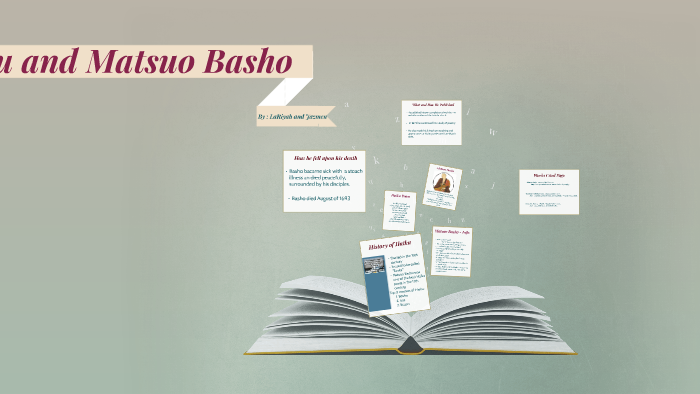



Haiku And Matsuo Basho By Lariyah Petty




About Haiku Poemshape
/ it is so sad to wake up!The spring haiku that Matsuo Basho () made has a seasonally free and easy characteristic, but some work are somewhat funny (it probably depended on his personality) As it was the lunar calendar until the Edo period in Japan, spring was between January and March Please enjoy the great 575 poems on comfortable season! Ang kahulugan ng haiku na ito ni Bashō ay Ambong o ambon ay malilit na patak ng ulan, na may maganda naidudulot sa mga matsing o sa pangkalahatan, mga hayop Ang mga matsing ay kalimitang naninirahan sa kagubatan o mga puno na nangangailangan ng tubig ulan Kaya ang ambon o ulan ay isa sa mga pangunahing pangangailangan ng mga hayop




A Zen Wave Basho S Haiku And Zen Basho Matsuo Aitken Robert Merwin W S Books
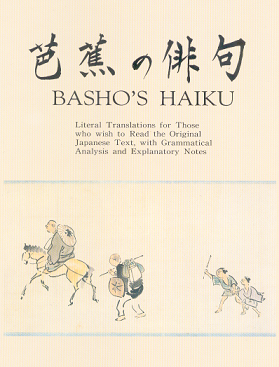



Haiku Of Basho
—Michael R Burch original haiku Basho's Heron This is Basho's response to the Takarai Kikaku haiku above asagao ni / ware wa meshi kû / otoko kana Ah me, I waste my meager breakfast morning glory gazing!Haiku by Basho on a traditional Japanese Scroll by Master Eri Takase Click below to see more original designs Taken ill on my travels,My dreams roam overthe withered moors 1旅に病んで夢は枯野をかけ廻るtabi ni yande yume wa kareno wo kake meguru12 1/4" W x 43" H Japanese Scrollby Master Japanese Calligrapher Eri Takase Matsuo Basho was a haiku poet of the early Edo period, and he is credited for elevating the haiku from a recreational form of wordplay to the status of literature as the world's shortest poetic form Basho was born in 1644 in the town of Ueno in Iga Province (presentday Iga city, Mie prefecture) as the second son of the Matsuo family




Batay Sa Nabasang Haiku Ni Basho Suriin Ang Tono Ng Pagbigkas Ng Tula Ipahayag Ang Damdaming Brainly Ph




De Wegen Van De Haiku Elisa Veini
Actually, the name "haiku" means "play verse" COMMENT This is probably the most famous poem in Japan, and after three hundred and more years of repetition, it has, understandably, become a little stale for Japanese people Thus as English readers, we have something of an edge in any effort to see it freshly76th Basho Memorial English Haiku Contest The Deadline Sunday, How to Apply Please apply by email Please write your haiku , your name, postal address, and email address A maximum of 10 haikus per person are allowed We only accept unpublished selfmade haikus Email eigo@bashobpjp Judge Hidetake KawarajiBasho (1644–1694) is the poet who crystallised the telegramlike or stenographylike haiku style a shorthand way of writing that should fit academic notetaking as well In his later years he was a student of Zen His later poems are his best They express mystical sensing or awareness
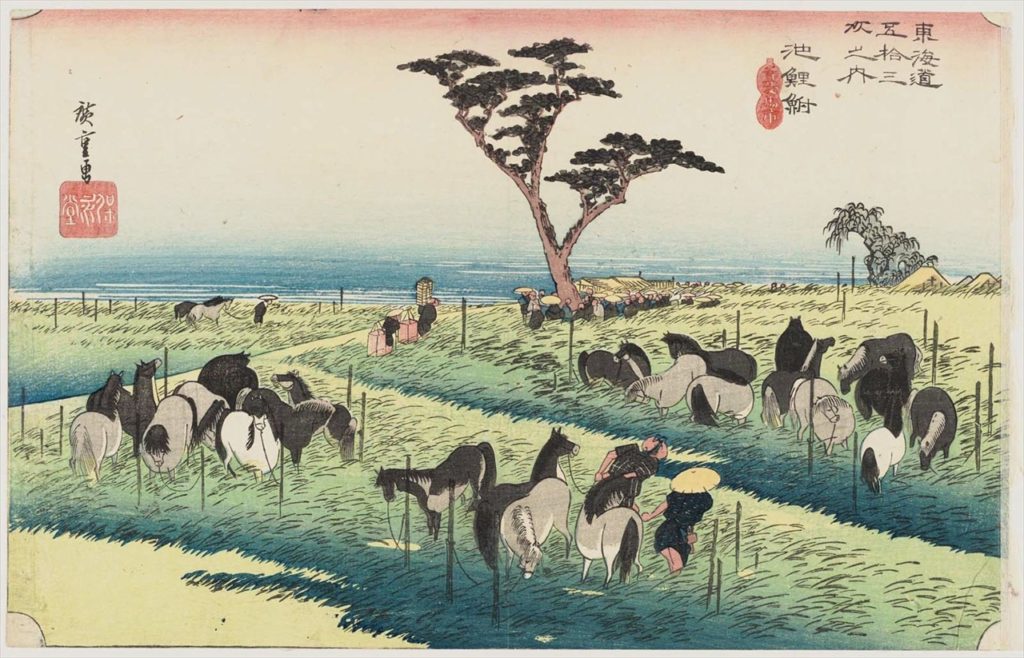



Haiku Poems Of Summer The Examples By Matsuo Basho Masterpieces Of Japanese Culture




Whrarchives Archives Of The World Haiku Review Page 11
B Y 2 X Aralin 1 Tanka ni Ki no Tomonori at Haiku ni Basho Japan (Isinalin sa Filipino ni Vilma C Ambat ) g m 1 p LAYUNIN F Sa pagtatapos ng aralin, ang mga magaaral ay inaasahan nang 1 Natukoy ang pagkakaiba at pagkakatulad ng estilo ng pagbuo ng tanaga at haiku mula sa E MgaThe HyperTexts Matsuo Basho Modern English Translations of the Japanese Haiku Master Matsuo Bashō was an ancient Japanese master of brief, startlingly clear and concise haiku/hokku and haikai no renga ("comic linked verse") also known as renkuBashō influenced many Western poets, including early English/American modernists like Ezra Pound and T S EliotSix Haiku by Bash� Te wo uteba kodama ni akuru natsu no tsuki as I clap my hands with the echoes, it begins to dawn — the summer moon Susuhaki wa ono ga tana tsuru daiku kana housecleaning day — hanging a shelf at his own house a carpenter Hototogisu otakeyabu wo moru tsukiyo hototogisu (little cuckoo) — through a vast bamboo forest




Salinanglahi Muni At Suri Ang Haiku Ay Isang Anyo Ng Tula Na Nagmula Sa
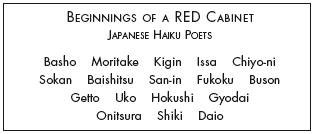



Mh Essay Haiku Geometry By Dru Philippou Spring 07
Basho¯'s Haiku Selected Poems by Matsuo Basho¯ araumi ya / sado ni yokotau / amanogawa Basho¯ was standing on the western shores of Japan looking out upon the night sea He was pausing on his long journey to the "deep north" of Japan, and he could hear the crashing of the Haiku ni BashŌ Isinalin sa Filipino ni Vilma C Ambat Filipino Matandang sapa Ang palaka'y tumalon Lumagaslas 24 TANAGA •Uri ng sinaunang tulang Pilipino na may layong linangin ang lalim ng pagpapahayag ng kaisipan at masining na paggamit ng antas ng wika •Binubuo ito ng tigpipitong pantig sa bawat taludtod ng bawat saknong(© Dmitri Smirnov) Waking in the night;



The Rough Sea 16 Muurgedichten Leiden
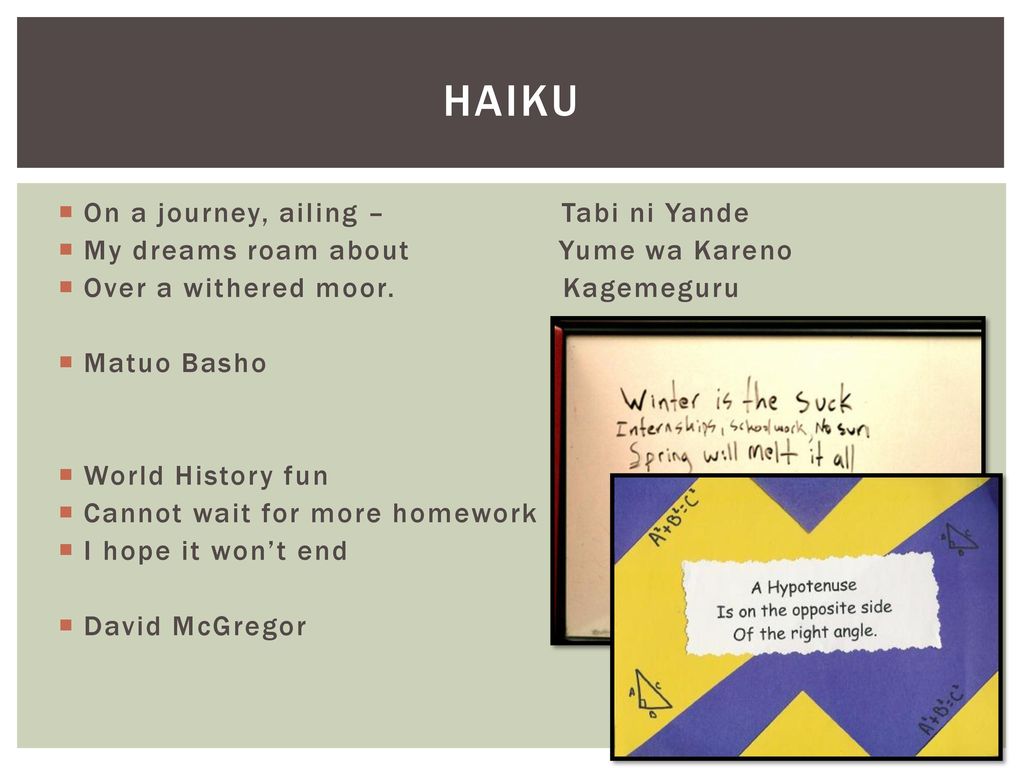



Japan Returns To Isolation Ppt Download
¯ THE HAIKU POETRY OF MATSUO BASHO stormy sea— stretching out over Sado, Heaven's River araumi ya / sado ni yokotau / amanogawa Basho¯ was standing on the western shores of Japan looking out This is Basho's haiku 鴬や餅に糞する縁の先 uguisu ya mochi ni fun suru en no saki Robert Hass translated this haiku into English Bush warbler shits on the rice cakes on the porch rail Matsuo Basho composed this haiku in 1692 when he was 49 years old In those days the word 'shit' was said to have never been used inSilence again From time to time The clouds give rest To the moonbeholders




Pdf A Crow On A Bare Branch A Comparison Of Matsuo Basho S Haiku Kare Eda Ni And Its English Translations




Haiku And Matsuo Basho By Lariyah Petty
Matsuo Bashō's haiku poems in romanized Japanese with English translations Editor Gábor Terebess (Hungary) abura kōri / tomoshibi hosoki / nezame kana The narrow tongue of flame, / the oil in the lamp is frozen; Matsuo Bashō ~ Selected Haiku Standard Matsuo Bashō () Japanese poetsaint and a lay Zen monk Some would argue, although not Masaoka Shiki, that he is the greatest master of Hokku and Renga to have ever lived He is also my personal favorite MATSUO BASHŌ'S FAMOUS haiku is a profound meditation on the power of poetry to express the inexpressible and convey the unspoken eloquence of all that is 閑かさや 岩にしみ入る 蝉の声 Shizukasa ya iwa ni shimiiru semi no koe deep silence the shrill of cicadas seeps into rocks —Matsuo Bashō (1644–94)




Vidales Four Basho Haiku Ni Zhou With Hsiao Tung Yuan Youtube




Write Your Own Haiku For Kids Isbn
The haiku reads "Since the crescent moon, I have been waiting for tonight" In the fashionable literary circles of Nihonbashi, Bashō's poetry was quickly recognized for its simple and natural style In 1674 he was inducted into the inner circle of the haikai profession, receiving secret teachings from Kitamura Kigin (1624–1705) Utagawa Hiroshige ( 歌川広重) 797 ~ 12 October 1858), was a Japanese ukiyoe artist, considered the last great master of that tradition His best known collection of block prints in horizontal format is One Hundred Famous Views of Edo and in vertical format The Fiftythree Stations of the TokaidōBasho nowaki shite A banana plant in the autumn gale Tarai ni ame o I listen to the dripping of rain Kiku yo kana Into a basin at night The haiku seems to suggest the poet's awareness of his spiritual affinity with the banana plant Some people who visited this teacher of




Hamaguri No Dividing Like Clam Haiku Poem And Painting Replica Matsuo Basho Genroku 2 16 細道 より道 松尾芭蕉




Tanka Ni Ki No Tomonori Pptx Pptx Tanka Ni Ki No Tomonori Haiku Ni Basho Japan Isinalin Sa Filipino Ni Vilma C Course Hero
The Haiku Foundation Digital Library Skip to main content The Haiku Foundation Digital Library Search using this query Basho The Complete Haiku Dublin Core Title Basho The Complete Haiku Subject Haiku, Japanesetranslations into English Basho, Matsuo Description 閑かさや 岩にしみ入る 蝉の声 しづかさや いはにしみいる せみのこゑ shizukasa ya iwa ni shimiiru semi no koe stillness— sinking into the rocks, cicadas' cry —Barnhill, Bashō's Haiku, 94, #392 the stillness— seeping into the rocks cicadas' screech —Ueda, Bashō and His Interpreters, 249 Quietness— Sinking into the rocks, A cicada's cry




Matsuo Basho Timeline Timetoast Timelines




16 Ideeen Over Haiga Gedichten Mooie Afbeeldingen Citaten




Bashō Matsuo Quote Even In Kyoto Hearing The Cuckoo S Cry I Long For Kyoto Quotes Of Famous People




Waiting For The Snow Winter Haiku Nippaku




Pdf Basho In Romaji And English Gabor Terebess Academia Edu




Poetry Japan Haiku And Tanka Cedar Gallery
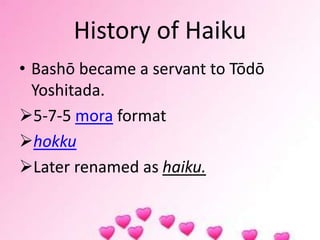



Matsuo Basho Haiku
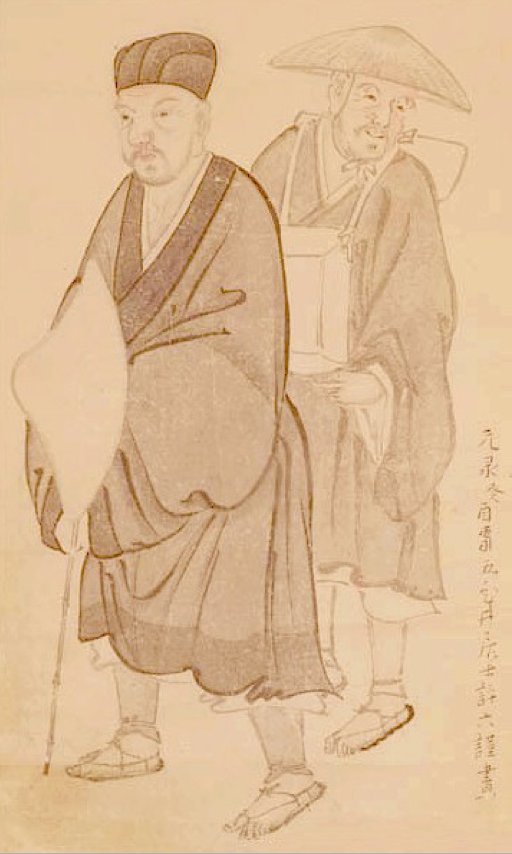



Best 10 Famous Matsuo Basho S Haiku Poems In English And Japanese Masterpieces Of Japanese Culture




Hatsu Makuwa First Makuwa Melon 4 Haiku Poems Replica Matsuo Basho Genroku 2 16 Original Homma Museum Of Art 細道 より道 松尾芭蕉




Selected Hokku By Basho With Multiple Translations By John Carley Issuu



Japanese Haiku And Matsuo Basho




Batay Sa Nabasang Haiku Ni Basho Suriin Ang Tono Ng Pagbigkas Ng Tula Ipahayag Ang Damdaming Brainly Ph



2




Basho S Haiku Book I By Anh Nhat Nguyen Issuu




The Rough Sea 16 Muurgedichten Leiden




The River Of Heaven The Haiku Of Basho Buson Issa And Shiki By Robert Aitken
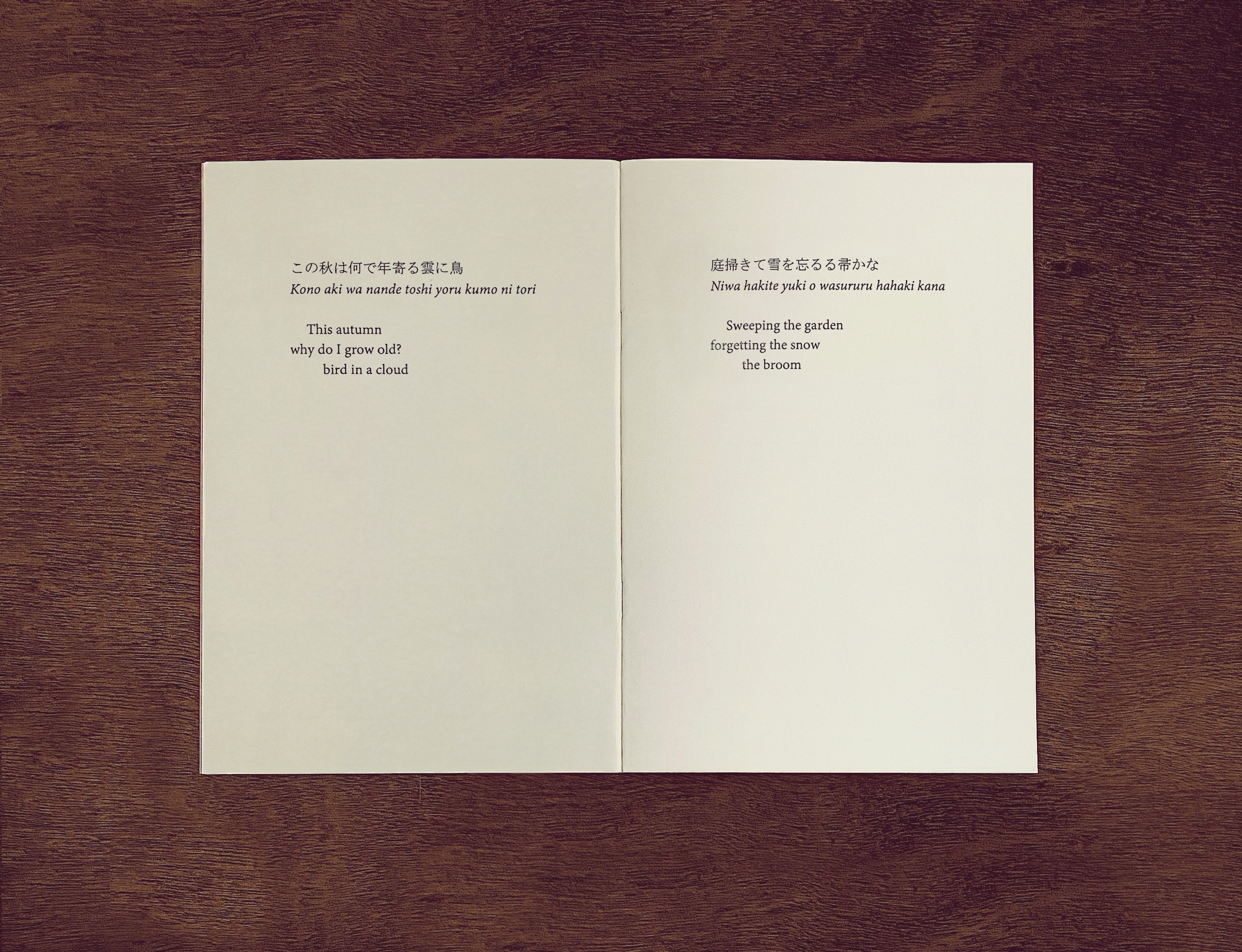



Poems Of Matsuo Basho The Economy Press




Pdf The Poet Vanishes Haiku By Chiyo Bashō And Buson




On Love And Barley Haiku Of Basho By Matsuo Bashō




Haiku The Art Of Japanese Poetry Part 2 By Omar Velarde Medium




Larrabee H Haiku Classic Japanese Short Poems Larrabee Hart Amazon Nl Boeken




Matsuo Bashō Wikipedia




Basho S Haiku By Jeroen Van Zanten Issuu




Calameo Buson




Tanka Ni Ki No Tomonori Pdf




Basho S Haiku By Jeroen Van Zanten Issuu



The Rough Sea 16 Muurgedichten Leiden




A Rare Pleasure Kyoto Journal




Uk954 Summer Maple Kingfisher Bird Haiku Basho Hanging Scroll Japanese Painting Antique Japanese Painting
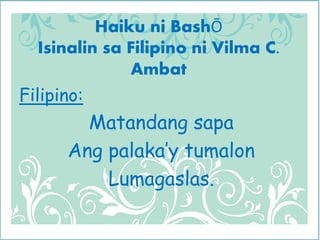



Tanka At Haiku
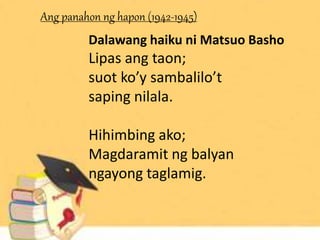



Haiku Sa Panahon Ng Hapon




On Love And Barley Haiku Of Basho By Matsuo Bashō




Laat Je Inspireren Door Een Haiku Creatief Met Zwarte Inkt
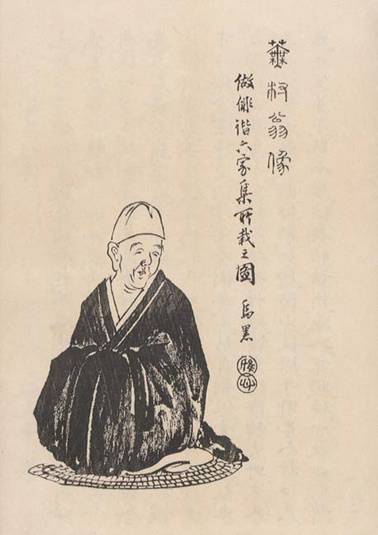



Yosa Buson S Haiku Terebess Asia Online Tao




Japanese Haiku By Basho Youtube




Basho S Haiku By Jeroen Van Zanten Issuu



Japanese Soul Haiku Reading Matsuo Basho Iromegane




Pdf Cross Cultural Poetry The Influence Of Japanese Haiku Poetry On English Modernpoetry A Comparative Study
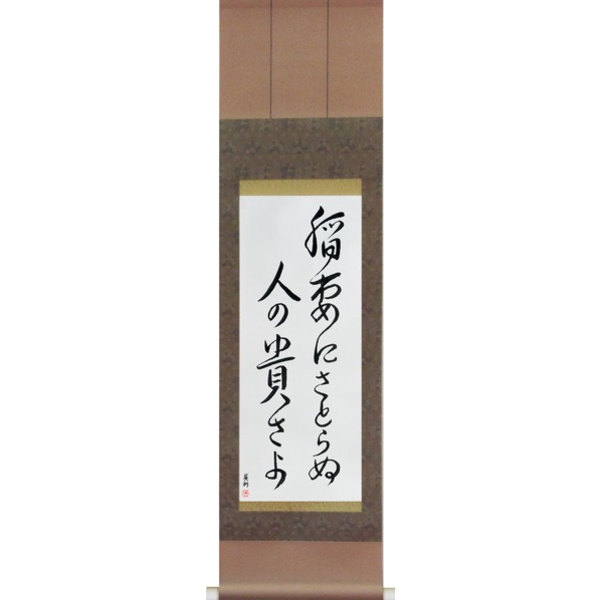



Basho How Admirable To See Lightning And Not Think Life Is Fleeting Inazuma Ni Satoranu Hito No Tattosa Yo Takase Studios




Basho Haiku Matsuo Bashō Png Image Transparent Png Free Download On Seekpng




Basho S Haiku By Jeroen Van Zanten Issuu




English Haiku かれ朶に烏のとまりけり秋の暮 Kareeda Ni Karasu No Tomarikeri Aki No Kure Painting By Morikawa Kyoriku 1656 1715 The Calligraphy By Matsuo Basho 1644 94 Idemitsu Art Museum 1680 81 Morikawa Kyoriku
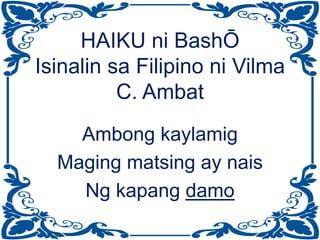



Tanka At Haiku



Paashaiku S 21 Booksandwords Be




Lost In Translation Considering The Possibility Of Haiku Translation Into English Universitarian
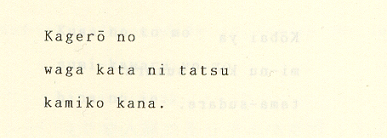



Haiku Of Basho



Matsuo Bashō Wikiwand
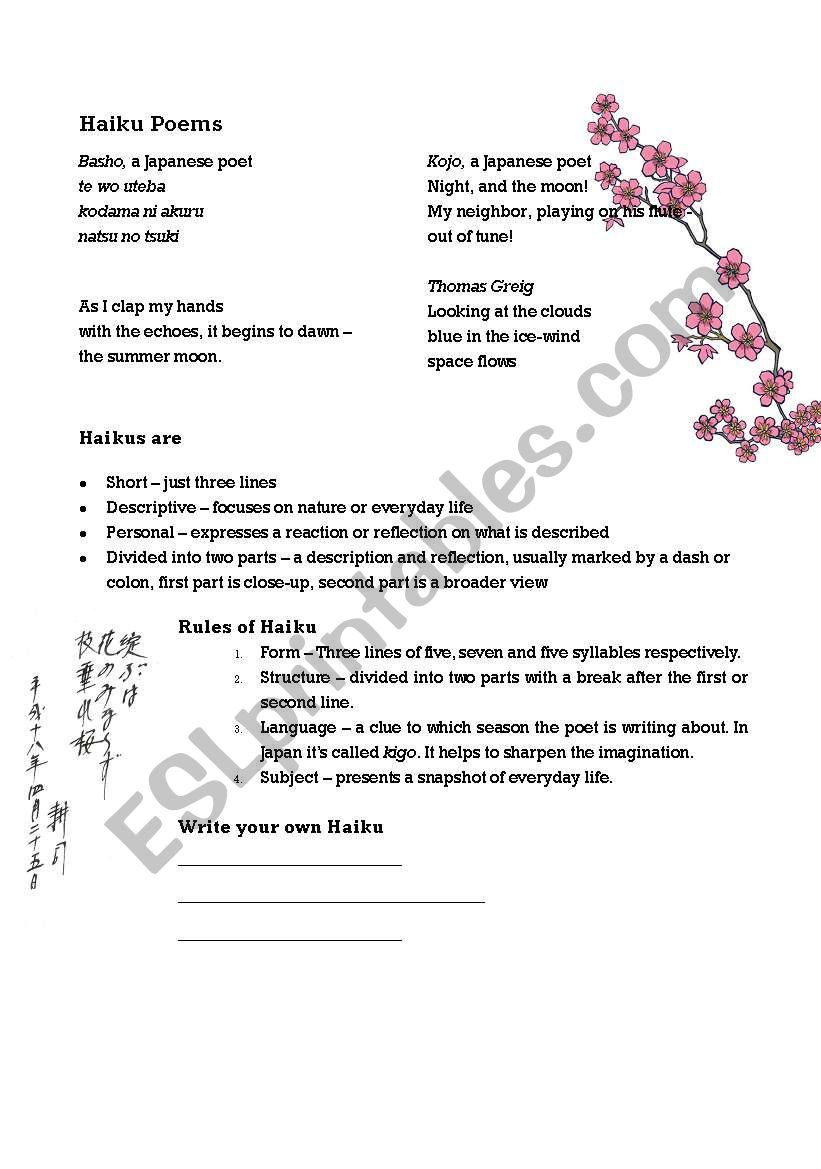



Haiku Poems Esl Worksheet By Svo000




Poem By Matsuo Basho Japanese 1694 Matsuo Basho 1644 1694 Was Revered As One Of The Greatest Stock Photo Picture And Rights Managed Image Pic Hez Agefotostock




Uk954 Summer Maple Kingfisher Bird Haiku Basho Hanging Scroll Japanese Painting Antique Japanese Painting




Matsuo Basho Wikipedia




Matsuo Basho Haiku Nl



1




Write Your Own Haiku For Kids Write Poetry In The Japanese Tradition Easy Step By Step Instructions To Compose Simple Poems Donegan Patricia Books Amazon




Haiku Wikiwand




Asagao Ni With Morning Glories Haiku Poem And Painting Replica Hanabusa Itcho Painting Matsuo Basho Calligraphy Tenna Period 17th Century Original Tenri Central Library Tenri University 細道 より道 松尾芭蕉




Do S And Don Ts Bij Het Schrijven Van Moderne Haiku Katern Japan
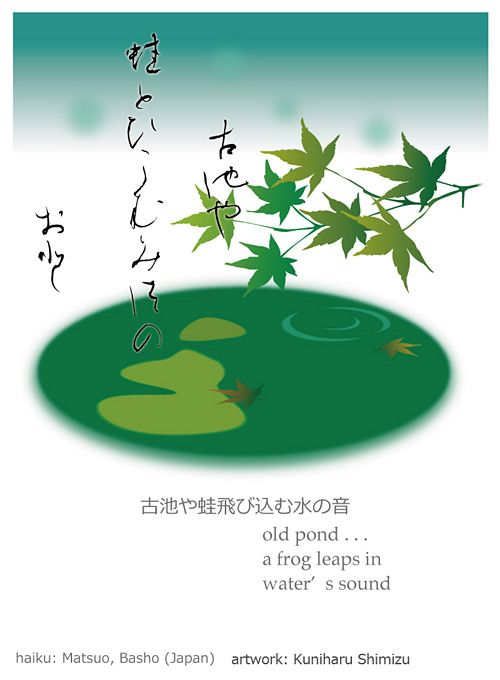



Manic Monday Random Theme Of Haiku Random And Not So Random Musings




Old Pond Comics A Fun Way To Learn Haiku Through Cartoons




Japanese Hanging Scroll Haiku By Basho Hitotsuya Ni




Ki No Moto Ni Under The Trees 3 Haiku Poems Matsuo Basho Genroku 3 1690 細道 より道 松尾芭蕉



Haiku Schrijven Do S And Don Ts Voor Schrijven Van Een Haiku



2



3




H3031ssvs5a Japanese Scroll Haiku By Basho As The Karate Ni Sente Nashi Em Kanji Png Image Transparent Png Free Download On Seekpng



1
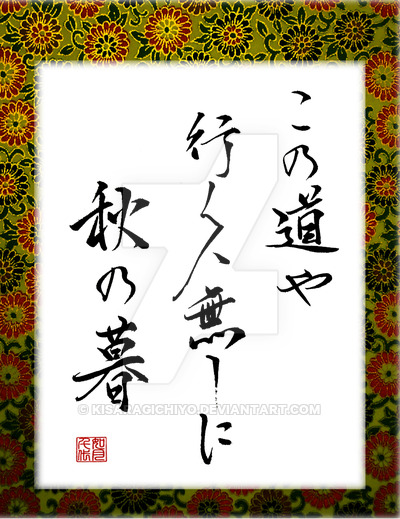



Haiku Kono Michi Ya By Kisaragichiyo On Deviantart




Haiku Topics Theory And Keywords Wkd Topics Travel Traveler S Sky




Pdf A Crow On A Bare Branch A Comparison Of Matsuo Bashō S Haiku Kare Eda Ni And Its English Translations Rene Ghelman Academia Edu




Basho S Haiku By Jeroen Van Zanten Issuu




Ad Blankestijn Haiku Travels 27 Basho And Nara Town




Haiku




5 2 Tanka Haiku G9 Pdf



Worldlit 108




English Haiku かれ朶に烏のとまりけり秋の暮 Kareeda Ni Karasu No Tomarikeri Aki No Kure Painting By Morikawa Kyoriku 1656 1715 The Calligraphy By Matsuo Basho 1644 94 Idemitsu Art Museum 1680 81 Morikawa Kyoriku



1
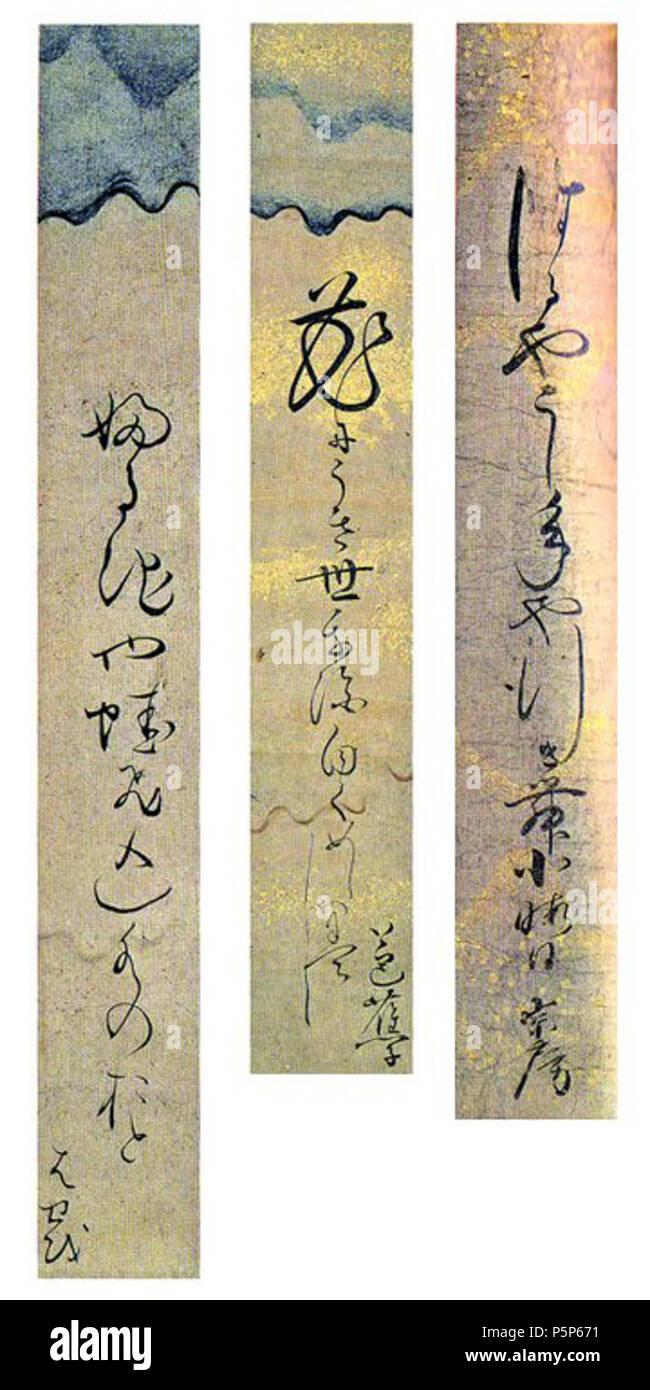



N A English Tanzaku Three Haiku Haru Ya Ib 1 Hana Ni Ib 148 Furuike Ya Ib 265 17th Century Matsuo Basho 174 Basho Tanzaku 1 Haru Ya 148 Hana Ni 265 Furuike Stock Photo Alamy
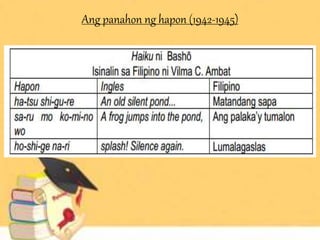



Haiku Sa Panahon Ng Hapon
コメント
コメントを投稿